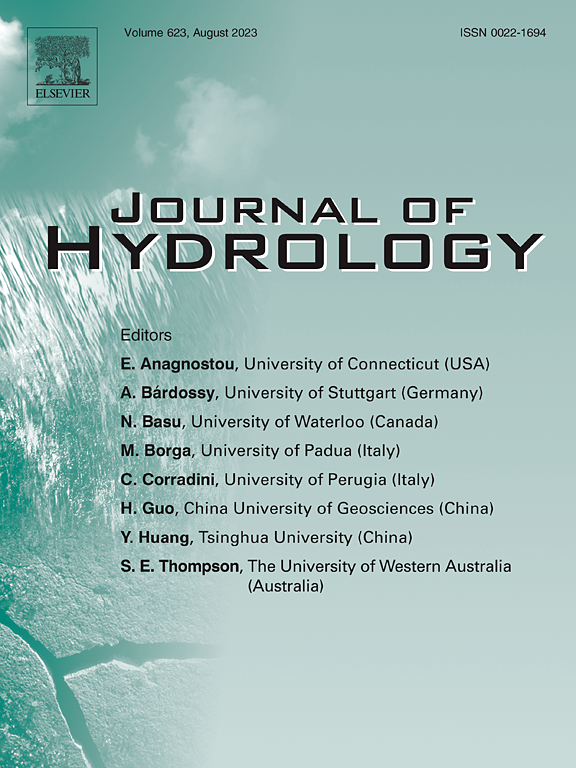蒙古高原气象、水文和农业干旱的传播过程及驱动机制研究
IF 5.9
1区 地球科学
Q1 ENGINEERING, CIVIL
引用次数: 0
摘要
干旱是一种极具破坏性的自然灾害,由于其多变的空间动态和复杂的传播过程,对水资源管理、生态系统平衡和社会经济发展构成了重大威胁。本研究利用ERA5-Land产品的温度、降水、径流和土壤水分数据,估算了不同时间尺度下的标准化降水蒸散指数(SPEI)、标准化径流指数(SRI)和标准化土壤水分指数(SSMI),分别可以代表气象、水文和农业干旱。利用交叉小波变换、最大Pearson相关系数法和地理探测器模型分析了1982 - 2021年蒙古高原干旱类型的演变特征、传播过程及其驱动因素。结果表明:(1)气象、水文和农业干旱在不同时间尺度上由湿润向干燥转变。(2) SPEI&SRI、SPEI&;SSMI和SRI&;SSMI在各时频周期内均呈显著正相关,且大部分相位箭头指向右下,表明存在一个气象-水文-农业干旱传播过程。(3) SRI对SPEI的反应时间在不同时间尺度上分别为7、5、3和3个月,而SSMI的反应时间分别为7、6、6和5个月。农业干旱对气象干旱的响应时间比水文干旱的响应时间长。(4)空间上,SRI和SSMI对SPEI的平均反应时间分别为4.72和5.30个月,而SRI对SSMI的平均反应时间为2.11个月。在极度干旱、干旱和半干旱地区,干旱的传播过程为气象-水文-农业;在半湿润和湿润地区,是气象-农业-水文。(5)降水和温度显著影响了气象干旱向水文和农业干旱传播的时空异质性,而风速是驱动水文干旱向农业干旱传播的关键因素。研究结果为认识干旱传播机制、建立干旱预警系统、提高综合抗旱性提供了理论依据。本文章由计算机程序翻译,如有差异,请以英文原文为准。
Study on the propagation processes and driving mechanisms of meteorological, hydrological, and agricultural droughts on the Mongolian Plateau
Droughts, extremely destructive natural disasters, pose a significant threat to water resource management, ecosystem balance, and socioeconomic development because of their variable spatial dynamics and complex propagation processes. In this study, temperature, precipitation, runoff, and soil moisture data from the ERA5-Land product were employed to estimate the Standardized Precipitation Evapotranspiration Index (SPEI), Standardized Runoff Index (SRI), and Standardized Soil Moisture Index (SSMI) at different time scales, which can represent meteorological, hydrological, and agricultural droughts, respectively. The cross-wavelet transform, the maximum Pearson correlation coefficient method, and the geodetector model were used to analyze the evolutionary characteristics, propagation processes, and drivers of these drought types on the Mongolian Plateau from 1982 to 2021. The results revealed the following: (1) Meteorological, hydrological, and agricultural droughts shifted from wetting to drying trends at different time scales. (2) There were significant positive correlations between the SPEI&SRI, SPEI&SSMI, and SRI&SSMI across various time–frequency periods, with most phase arrows pointing down to the right, thus suggesting a meteorological-hydrological-agricultural drought propagation process. (3) The response times of the SRI to the SPEI at the different time scales were 7, 5, 3, and 3 months, whereas for the SSMI, the response times were 7, 6, 6, and 5 months, respectively. The response time of agricultural drought to meteorological drought was longer than that of hydrological drought. (4) Spatially, the average response times of the SRI and SSMI to SPEI were 4.72 and 5.30 months, respectively, whereas the response time of the SRI to SSMI was 2.11 months. In hyper-arid, arid, and semi-arid regions, the drought propagation process was meteorological-hydrological-agricultural; in sub-humid and humid regions, it was meteorological-agricultural-hydrological. (5) Precipitation and temperature significantly influenced the spatiotemporal heterogeneity in the propagation from meteorological drought to hydrological and agricultural droughts, while wind speed was a crucial factor driving the propagation from hydrological to agricultural droughts. These findings provide a theoretical basis for understanding the drought propagation mechanism, establishing a drought warning system, and improving comprehensive drought resistance.
求助全文
通过发布文献求助,成功后即可免费获取论文全文。
去求助
来源期刊

Journal of Hydrology
地学-地球科学综合
CiteScore
11.00
自引率
12.50%
发文量
1309
审稿时长
7.5 months
期刊介绍:
The Journal of Hydrology publishes original research papers and comprehensive reviews in all the subfields of the hydrological sciences including water based management and policy issues that impact on economics and society. These comprise, but are not limited to the physical, chemical, biogeochemical, stochastic and systems aspects of surface and groundwater hydrology, hydrometeorology and hydrogeology. Relevant topics incorporating the insights and methodologies of disciplines such as climatology, water resource systems, hydraulics, agrohydrology, geomorphology, soil science, instrumentation and remote sensing, civil and environmental engineering are included. Social science perspectives on hydrological problems such as resource and ecological economics, environmental sociology, psychology and behavioural science, management and policy analysis are also invited. Multi-and interdisciplinary analyses of hydrological problems are within scope. The science published in the Journal of Hydrology is relevant to catchment scales rather than exclusively to a local scale or site.
 求助内容:
求助内容: 应助结果提醒方式:
应助结果提醒方式:


